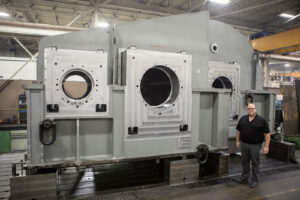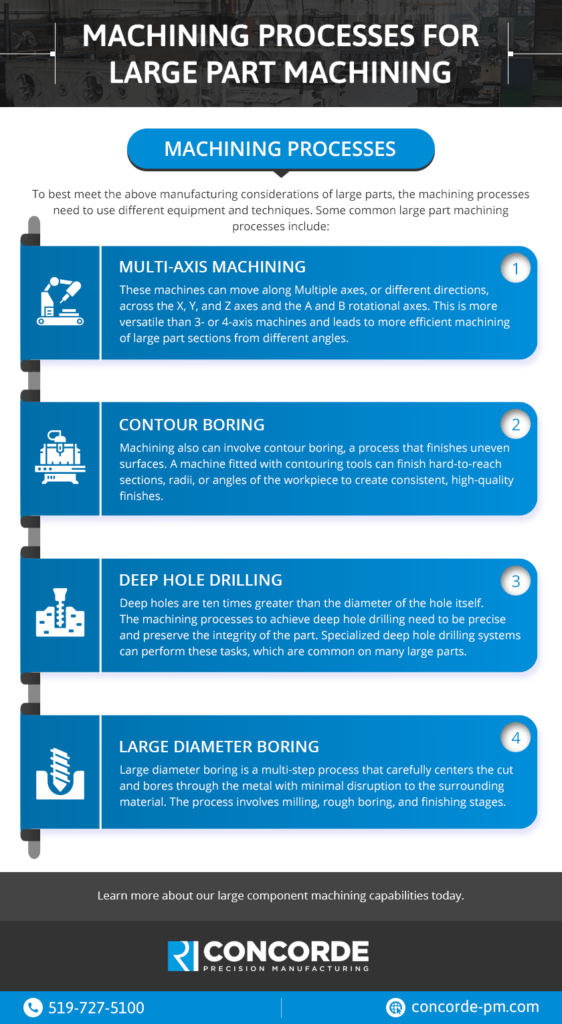What Makes Large Part Machining Different?
 Machining large components presents challenges at every turn. For example, complex parts that need to undergo multiple stages of machining and finishing are difficult to move from station to station. Large parts also can be too big to fit within CNC machine work zones or inspection areas and they can be too heavy for workers to move or lift safely. When your next project calls for large part machining, it’s important to look for professionals who have the specialized equipment and experience to meet the job’s unique challenges.
Machining large components presents challenges at every turn. For example, complex parts that need to undergo multiple stages of machining and finishing are difficult to move from station to station. Large parts also can be too big to fit within CNC machine work zones or inspection areas and they can be too heavy for workers to move or lift safely. When your next project calls for large part machining, it’s important to look for professionals who have the specialized equipment and experience to meet the job’s unique challenges.
Design Considerations
High-quality, large part machining starts with the equipment that can produce the parts. Manufacturers must have the machinery and work processes to handle the challenges of machining large parts, including the following:
Temperature
Machining parts generates heat, either directly through the cutting mechanism or indirectly due to friction. This heat drastically increases during the machining of large parts, often requiring a cooling period between the various machining operations. This must be accounted for to ensure the integrity of the part.
Accuracy and Speed
Rather than completing the piece in a single pass, large part machining professionals make incremental changes. This initial time investment increases the quality of the workpiece and decreases the risk of expensive delays and modifications.
Another accuracy factor that can affect large pieces is distortion. Large parts are even more vulnerable to distortion caused by stress throughout the production process. While careful machining techniques are essential, it’s also important to use CMM verification processes to inspect the part at different stages and ensure it stays within acceptable tolerances.
Machinery
Large part machining requires the use of equipment with larger work zones and greater reach. For example, a large Gantry style vertical CNC machine has a larger work envelope than a vertical machining center.
Machining Processes
To best meet the above manufacturing considerations of large parts, the machining processes need to use different equipment and techniques. Some common large part machining processes include:
Multi-Axis Machining
These machines can move along Multiple axes, or different directions, across the X, Y, and Z axes and the A and B rotational axes. This is more versatile than 3- or 4-axis machines and leads to more efficient machining of large part sections from different angles.
Contour Boring
Machining also can involve contour boring, a process that finishes uneven surfaces. A machine fitted with contouring tools can finish hard-to-reach sections, radii, or angles of the workpiece to create consistent, high-quality finishes.
Deep Hole Drilling
Deep holes are ten times greater than the diameter of the hole itself. The machining processes to achieve deep hole drilling need to be precise and preserve the integrity of the part. Specialized deep hole drilling systems can perform these tasks, which are common on many large parts.
Large Diameter Boring
Large diameter boring is a multi-step process that carefully centers the cut and bores through the metal with minimal disruption to the surrounding material. The process involves milling, rough boring, and finishing stages.
<Explore the difference between drilling and boring for large components.>
Choose Concorde Precision Machining for Large Part Machining
Large part machining is a specialized set of processes for oversized parts that need careful handling and machining. Because of their size, these parts have unique heat, distortion, and weight considerations. Work with a professional large part machining service to ensure the parts are machined and finished with the specialized equipment to meet tight tolerances and protect the integrity of the parts. Contact our team at Concorde Precision Machining today to learn more about our large component machining capabilities, including remanufacturing of large industrial components.



